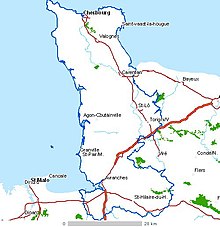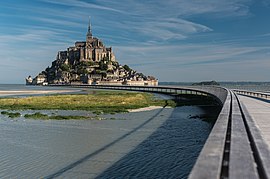|
Manche
Manche (/mɒ̃ʃ/, French pronunciation: [mɑ̃ʃ] ⓘ; Norman: Maunche) is a coastal French département in Normandy on the English Channel, which is known as La Manche, literally "the sleeve", in French. Manche is bordered by Ille-et-Vilaine and Mayenne to the south, Orne and Calvados to the east, the English Channel to the west and north and by sharing maritime borders with the Crown Dependencies of Bailiwick of Jersey and Bailiwick of Guernsey of the United Kingdom to the west. It had a population of 495,045 in 2019.[3] HistoryManche is one of the original 83 Departments of France, established during the French Revolution on 26 February 1790. It was created from part of the province of Normandy. The capital was Coutances until 1796, and it resumed that role after World War II because of the almost complete destruction of Saint-Lô during the Battle of Normandy following D-Day. When Saint-Lô was rebuilt, it once again became the capital. Geography The department includes the Cotentin Peninsula down to the famous Mont St Michel. Of the Channel Islands, only the island of Chausey forms part of the territory of the department. Manche borders the Normandy departments of Calvados to the east and Orne to the southeast. Mayenne, a department of the Pays de la Loire, is to the south-east, and Ille-et-Vilaine in Brittany is to the south-west and it shares maritime borders with Bailiwick of Jersey and Bailiwick of Guernsey of the United Kingdom to the west. The salient of this department is the longest in France. It is also the second longest salient in Europe, after Odesa Oblast in Ukraine. The region is lush and green with sandy beaches and remains oriented towards farming. The peninsula was originally joined as a single land mass to Cornwall and Dorset in England, meaning that the underlying geological strata of both regions are very similar. However, there are substantial regional differences today in terms of flora and fauna, and farming practices have varied considerably between the United Kingdom and France. Flat marsh areas in the department attract many bird-watchers. The region in and around St Lô is also the equestrian capital of France, where the cooler climate compared to the south is ideal for breeding and training. France's first EPR nuclear reactor is under construction at Flamanville near Cherbourg and is planned to start operations in late 2023.[4] Principal townsThe most populous commune is Cherbourg-en-Cotentin; and the prefecture Saint-Lô is the second-most populous. As of 2019, there are six communes with more than 10,000 inhabitants:[3]
ClimateThe climate is oceanic with relatively mild winters in which temperatures go below zero only for a few days. Summer temperatures are usually around 20 °C, and can occasionally reach 35 °C in direct sunlight. Precipitation is heavy but varies greatly by region, from 700mm on the coast to 1300mm in the southern central area. Highly localised but not life-threatening flash flooding has been experienced during the last few springs. The west coast benefits from the influence of the Gulf Stream and this has enabled the naturalization of Mediterranean and exotic plants such as mimosas, palms, and agaves. There is often a sea breeze on the coast, which combined with tides, contributes to rapid temperature changes in the course of a single day. Sea temperatures can be very pleasant for swimming between June and October. DemographicsInhabitants of the department are called Manchots or Manchois. Population development since 1801:
PoliticsThe president of the Departmental Council is Jean Morin, elected in July 2021. Presidential elections 2nd round
Current National Assembly RepresentativesSports
Tourism
See also
References
External linksWikimedia Commons has media related to Manche.
|
||||||||||||||||||||||||||||||||||||||||||||||||||||||||||||||||||||||||||||||||||||||||||||||||||||||||||||||||||||||||||||||||||||||||||||||||||||||||||||||||||||||||||||||||||||||||||||||||||||||||||||||||||||||||













